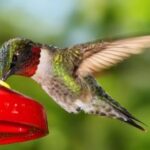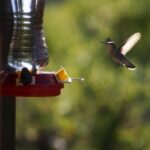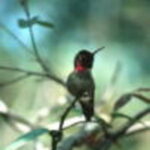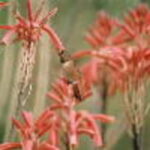The state of Ohio may be known as the buckeye state, and is home to sports teams including the Cincinnati Reds, the Cleveland Indians, the Cincinnati Bengals, the Cleveland Browns and many more teams, it is not best known for its hummingbird population, even though it does have one and this population appears to be increasing annually. Hummingbird enthusiasts in this midwest state have the opportunity to be visited by at least one hummingbird species, the Ruby-throated Hummingbird, most any spring as it is the most commonly seen and documented in Ohio. But, to hummingbird enthusiasts delight, two other species have been documented as well, they are the Rufous Hummingbird and the Calliope Hummingbird. Of these two hummingbird species, the Rufous is more common and documented visits of this species are increasing each year. On the other hand, there have not been very many sightings or documentation of the Calliope Hummingbird in Ohio, which makes one believe that this species does not visit Ohio except when they get off their normal migration route.
Identifying these tiny visitors can be as interesting as watching them as they feed on carefully placed hummingbird feeders or on carefully maintained hummingbird gardens. Unfortunately, identifying them may not be as easy as maintaining hummingbird feeders or hummingbird gardens. However, with a little help and a few hints of what to look for, this can be accomplished. To begin with, try to get a good look at the tiny bird’s throat; this can be the biggest clue to the identity of the bird in question, as most species of hummingbirds in Ohio have different colored throats and even breasts. Another location to pay attention to is the birds back and crown, their color is important when attempting to identify the hummingbird. One other thing to keep in mind is that the male of the species is the most colorful and thus will be easiest to identify. Identification of hummingbirds in Ohio can be accomplished when these features are carefully studied.
The male Ruby-throated Hummingbird is the easiest hummingbird in Ohio to identify. It has a ruby-red throat, which may look black if the light is not just right. This male hummingbird also has an emerald back and a forked tail. The female Ruby-throated Hummingbird also has an emerald back, like the male, but that is where the same similarities between the sexes end. The female has a white throat, white breast and rounded tail feathers. The Ruby-throated Hummingbird is found first in southern Ohio in late April and continue to arrive until mid-May. Fall migration for these tiny birds usually ends by mid-August for males, the end of August for females and juveniles may hang around until mid-October.
The male Rufous Hummingbird, like the male Ruby-throated Hummingbird, is the easiest of the Rufous Hummingbirds to identify. The throat of the male Rufous is orange-red, it has a white breast and rufous or rust color covers its crown, tail and sides. This male hummingbird’s back can vary from green, rufous or a combination of the two colors. The female Rufous Hummingbird is also less colorful than the male, just as with the Ruby-throated Hummingbirds. In fact, she resembles the female Ruby-throated Hummingbird more than the male Rufous Hummingbird with her green back and crown, white breast, streaked throat and rufous tail feathers that are white tipped. The Rufous Hummingbirds are visitors to Ohio during the fall migration and are usually seen in the fall and winter months.
The Calliope Hummingbird is the rarest hummingbird documented in Ohio, with one being reported in October, 2002. Even with this being rarely seen, identifying it may prove important if one happens to show up at the readers hummingbird feeder or hummingbird garden. The male Calliope Hummingbird is the smallest hummingbird to visit Ohio, usually weighing in the neighborhood of 2.5 grams. This tiny hummingbird has a white throat with purplish rays scattered throughout it that cause a whiskered effect. It also has a metallic green back and crown. The female Calliope Hummingbird is also small, but somewhat larger than its male counterpart is. It is hard to distinguish from the other female hummingbirds in Ohio, except for its size, but it does have other features to look for such as a very short, straight bill, a short green tail that has white corners and when it is perched, its wings extend past its tail feathers.
With the population of hummingbirds in Ohio being so small, it is often a good idea to plan on their arrival. This means that hummingbird enthusiasts should know how to fix the sugar water to put in a feeder and when the appropriate time to hang these feeders occurs in their area of the state. Hummingbird feeders are filled with sugar water that is mixed by adding 1/4 cup of sugar to 1 cup of water. This mixture is allowed to boil and cool, then is added to the feeder. The feeder should be cleaned and restocked at least weekly, more if needed. Hummingbird enthusiasts should also know what plants to include in a hummingbird garden if they choose to attract these tiny visitors this way. These plants include coral bells, lilac, red hot poker, gladiolus, Mexican sunflower, trumpet vine, scarlet runner beans, Alpine Columbine, delphinium, cheddar pinks, bee balm, dwarf catmint and dwarf Russian sage.






